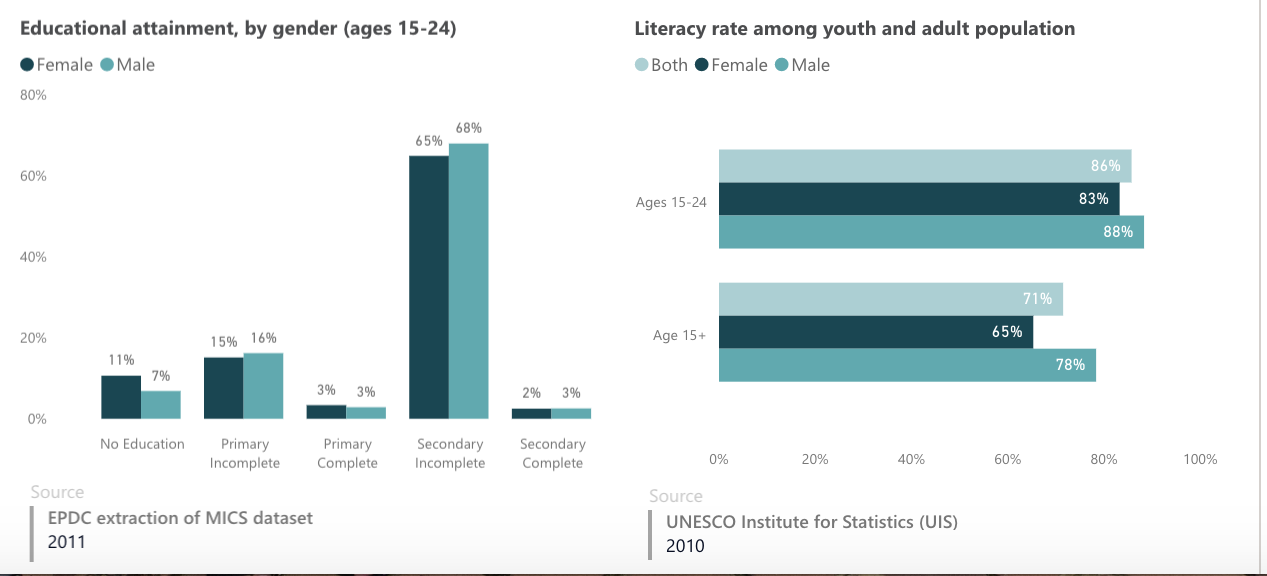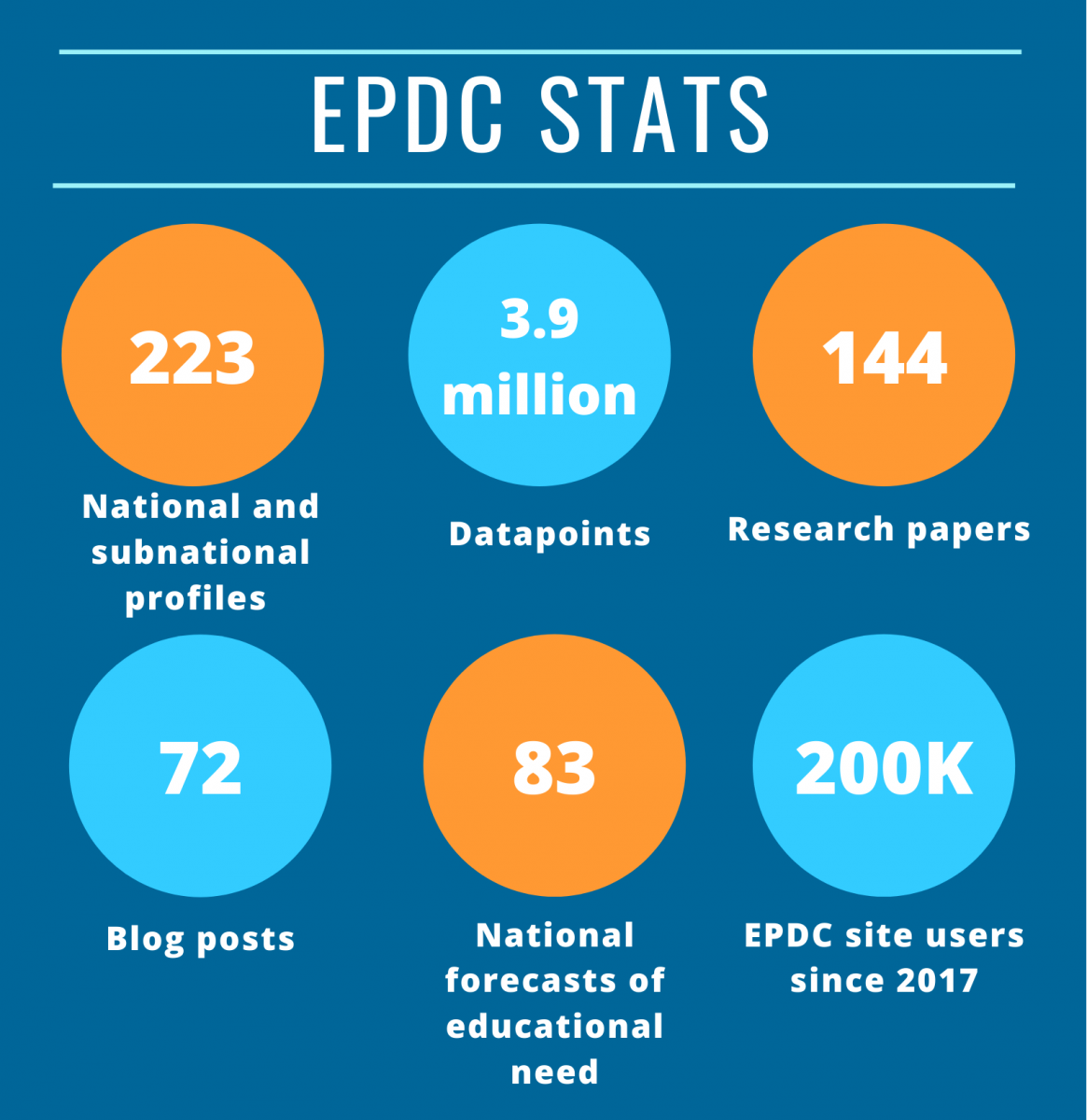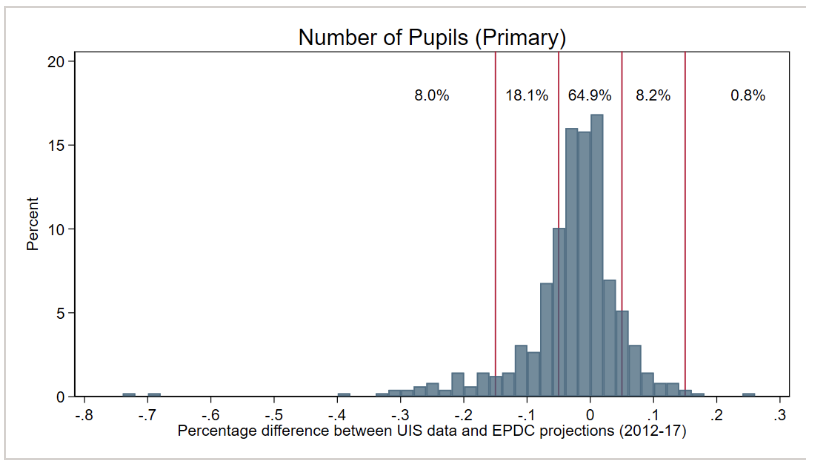You are here
The Legacy of EPDC
Dear friends:
On April 15, 2020 we will be retiring Education Policy and Data Center resources and would like to take this moment to celebrate EPDC and express our gratitude for the opportunity to contribute to the global knowledge and information on education systems over the past 16+ years.
EPDC was launched in 2003 with support from USAID, as a unique data resource that served the education community by aggregating a myriad data sources – including international databases, national statistical agency data, household surveys, international, regional, and national student assessments, and more. Former EPDC Research Associate, Elizabeth Buckner shares that she “saw it as serving the educational development community by taking technical sources of data and making them available and insightful to non-technical users.”
Figure 1. EPDC country landing page


Over time, EPDC developed resources for decision makers in education, including ministries of education, donor agencies, researchers, and journalists chronicling educational developments. According to former Director of the Global Learning Business Unit, FHI 360 and AED, John Gillies, EPDC was responsible for “injecting new approaches, analyses, insights into the global dialogue. It was a small, but important global actor whose freedom of action and creativity contributed to this growth.”
Measurement in education was a key objective for EPDC across the years. EPDC was among the first to bring data from multiple data sources, including household surveys and national administrative sources, into a single database, harmonizing indicators across systems for cross-national comparability, and making country- and subnational-level information available to a broad audience. To assist policy makers in using education data, EPDC provided capacity building and training in data management and application, working with counterparts such as the Ministries of Education and donor organizations.
In the early 2000’s, education projections established EPDC as a resource for practitioners and policy makers in the field of international education. With its education projections, EPDC supported the Education for All Global Monitoring Report (now the Global Education Monitoring Report) and subsequently, the Global Partnership for Education in tracking the rate of progress against 2015 targets and identifying the gaps between goals and reality. In our recent blog post, we shared how our projections held up against actual progress in recent years, and found that barring major crises, our expectations of the dynamics of school enrollment around the world was generally within a small margin of reality. In addition to the projections, EPDC contributed several background papers for the GMR, examining issues of issues and quality in education to inform the Report and subsequent discussions.
Figure 2. Accuracy of EPDC projections for number of primary pupils

Over the past decade, EPDC contributed to several important initiatives that moved the field of education forward in knowledge and understanding of the challenges. The most recent of these has been the Education Equity Research Initiative, where EPDC staff have led the development of several measurement tools and methodologies, which will remain available on the Equity Initiative website. Some of the research products developed in support of the Equity Initiative include the Structured Questions for Equity Analysis, the Handbook on Measuring Education Equity developed by UNESCO Institute for Statistics and Cambridge University, and a mapping of existing disability screening tools
In 2015-2016, EPDC supported the Brookings Institution’s Breadth of Learning Initiative, developing a school survey to examine the breadth and coverage of school curriculum. As a contribution to the discussion of the breadth of curriculum and assessment, EPDC carried out a mapping of national learning assessments against the seven Learning Metrics Task Force domains.
In 2015-2016, EPDC carried out the OECD Teacher Professionalism study, conceptualizing an index of teacher professionalism through the TALIS 2013 survey administered to teachers in 34 countries, and examining the differences in teacher professionalism domains across the TALIS participating education systems.
Another critical engagement for EPDC was our contribution to the understanding of the linkages between education inequality and violent conflict, in support of the UNICEF Peacebuilding, Education and Advocacy Research Programme. Figure 3 displays the Education in Conflict (EiC) coverage by ethnicity, religion, and subnational group. Through this project, we found that this relationship is strong and mutual, with inequality contributing to the risk of violent conflict and conflict further exacerbating existing levels of education inequality. Two case studies, Uganda and South Africa, provided an additional look at how education systems sought to use their resources to address inequity and strengthen social cohesion. These are just some examples of the many research projects, collaborations, and contributions EPDC made over the years.
Figure 3. Country Coverage by Type of Inequality
.png)
EPDC Alumni Share Thoughts
We take pride in the contributions that EPDC made to the field of education over the past 16+ years. To celebrate the work of EPDC, we asked a few EPDC alumni to share their thoughts on the role and legacy of EPDC during their time, and since then. Read more here.
Follow Us!
While EPDC may be going away, the EPDC team remains at FHI 360, and continues to support an array of research and analytical activities. Please follow them:
- Carina Omoeva, PhD, Director, Research & Evaluation Department
- Wael Moussa, PhD, Education Research Scientist, Research & Evaluation Department
- Nina Menezes Cunha, PhD, Senior Research Associate, Research & Evaluation Department
- Rachel Hatch, MA, Research Associate, Research & Evaluation Department
Our resources will continue to be available on www.EPDC.org, albeit without updates. More recent publications can be found on ResearchGate, where EPDC has a Lab Page.
Do YOU have reflections, questions, or concerns about EPDC? There is still time to contact us at epdc@fhi360.org. We will be happy to hear from you!
Still interested in exploring our data, resources, and visualizations? Visit the site before April 15th! Following this date, all interactive features will be in archive mode.
We are grateful for the support we've received across the many years of making sense of data to improve education for development. Thank you.
Sincerely,
The EPDC Team

Add new comment